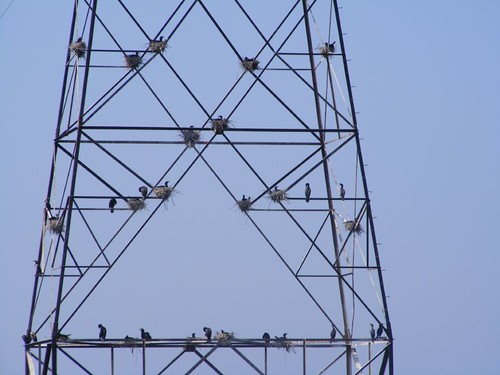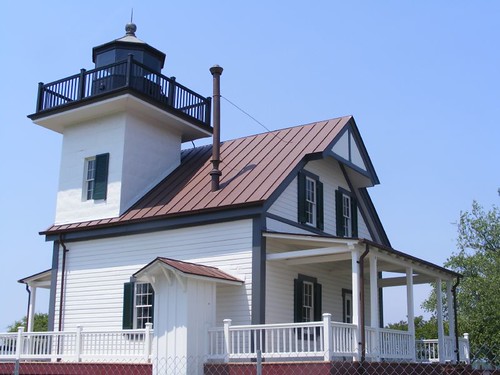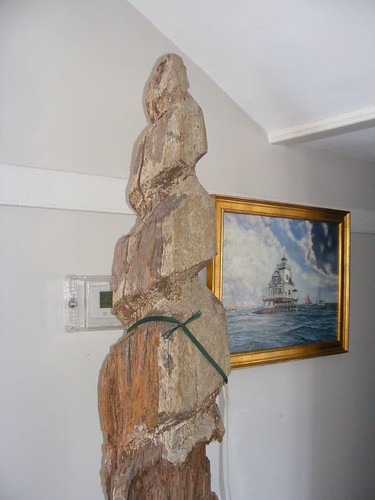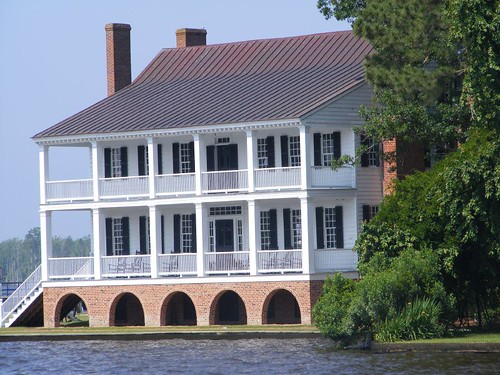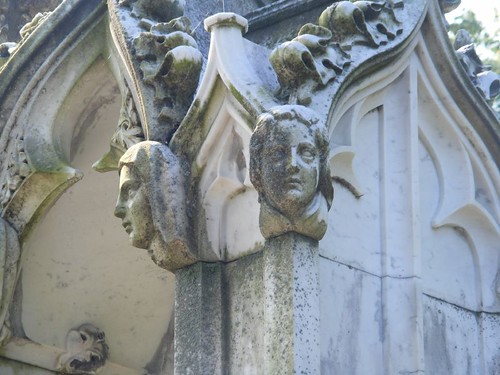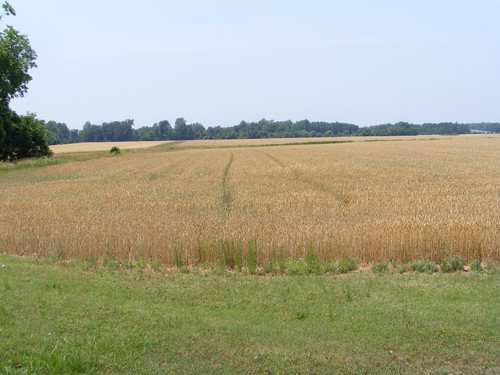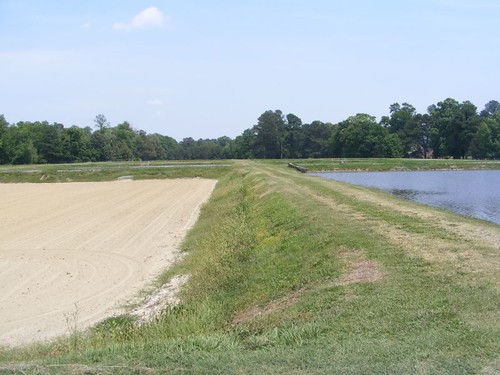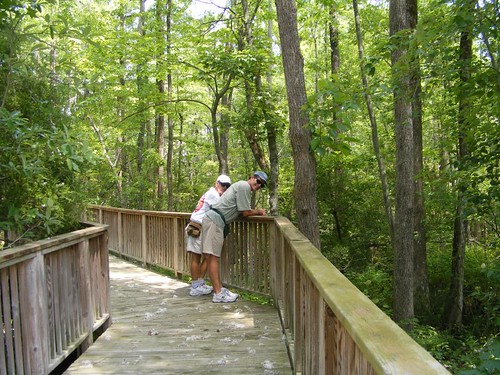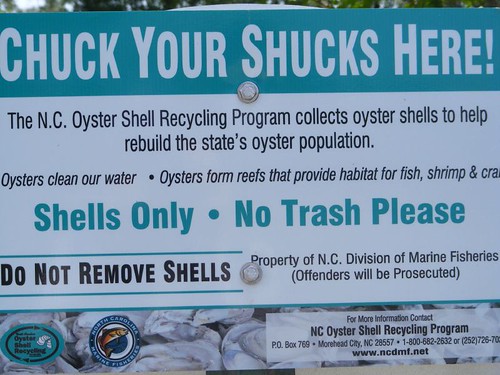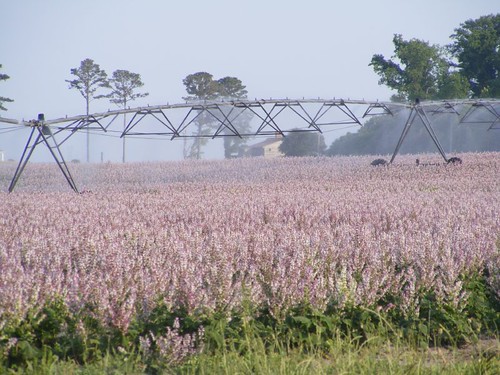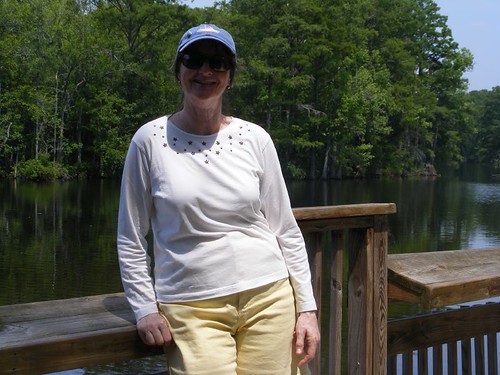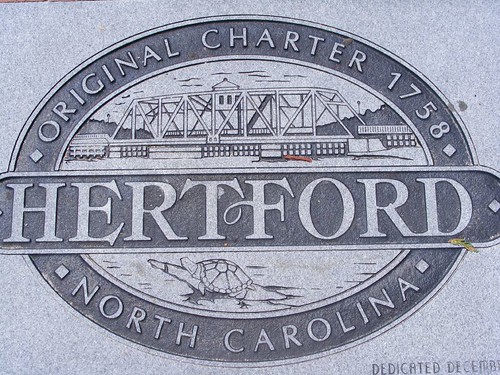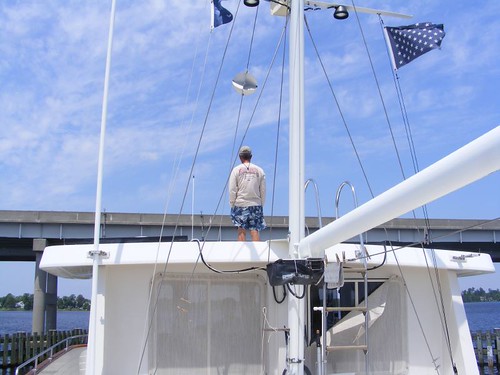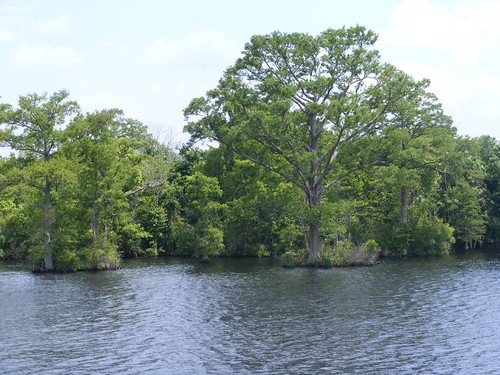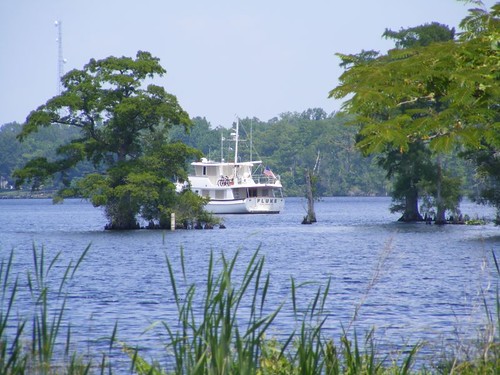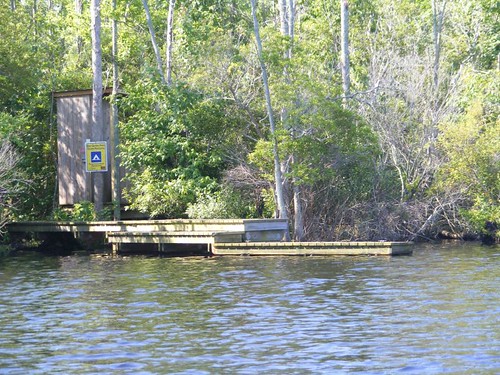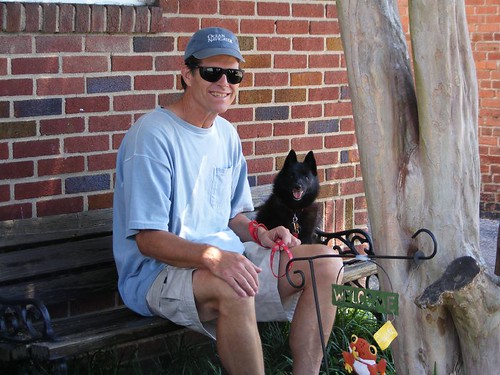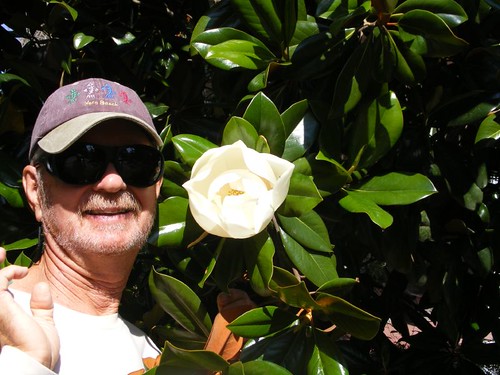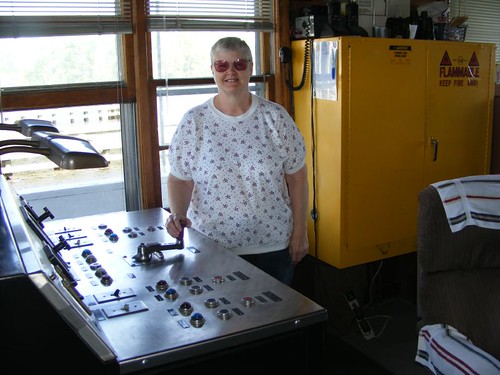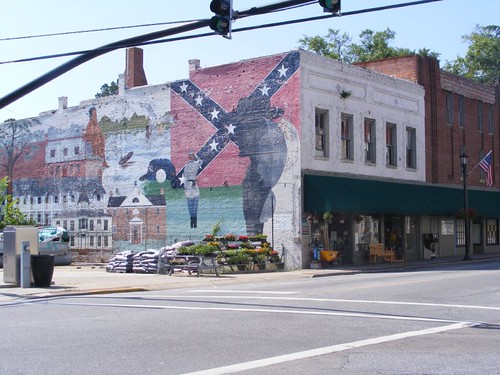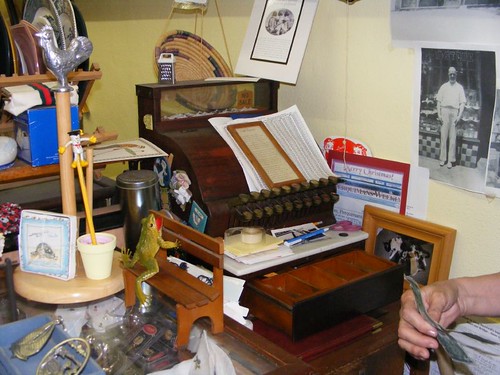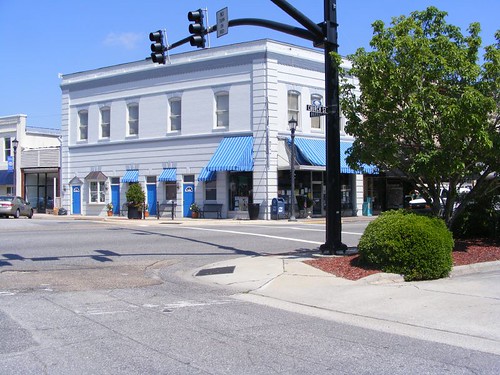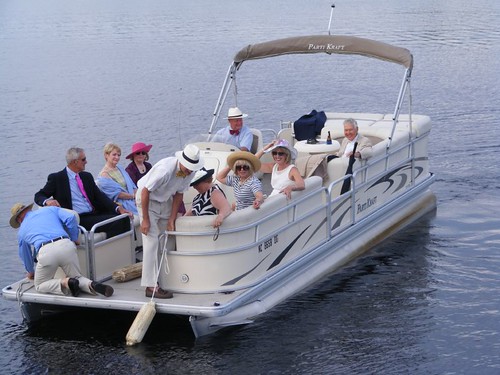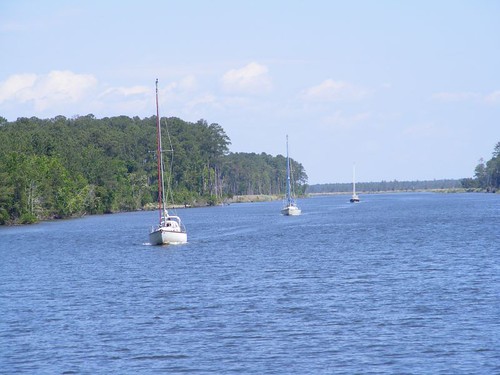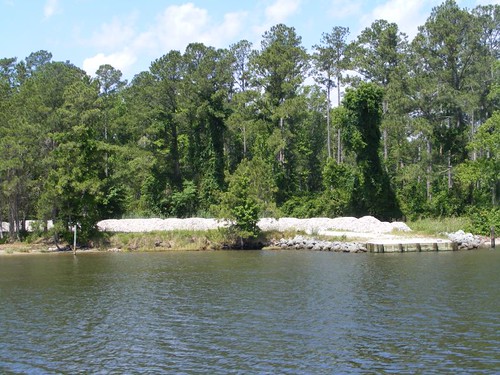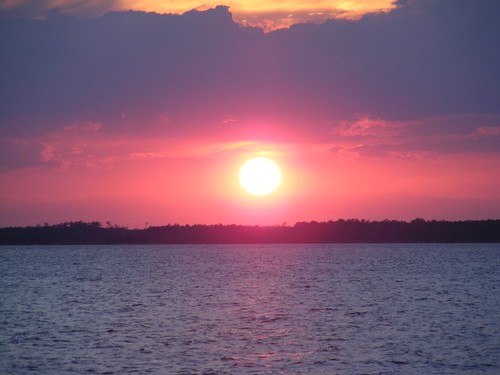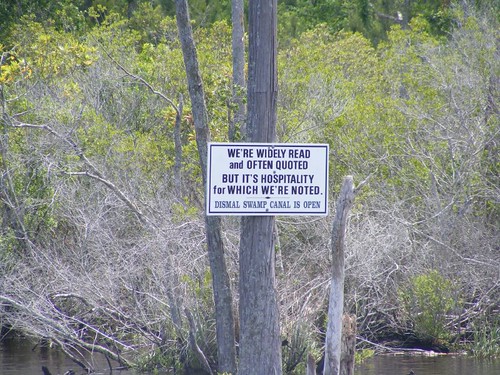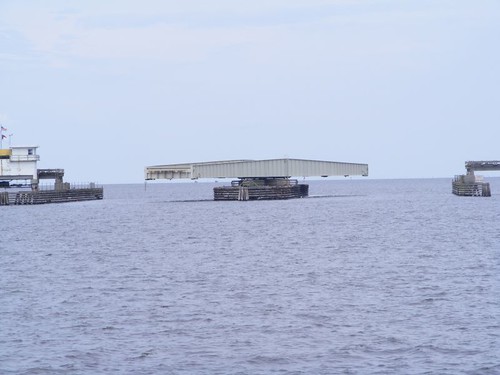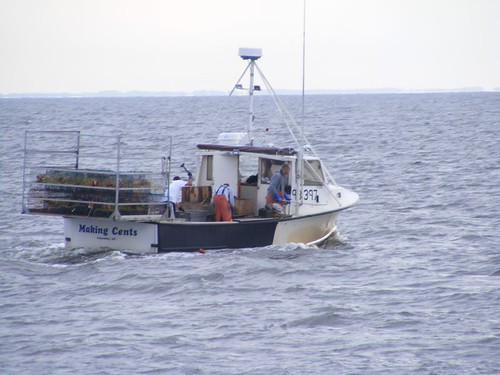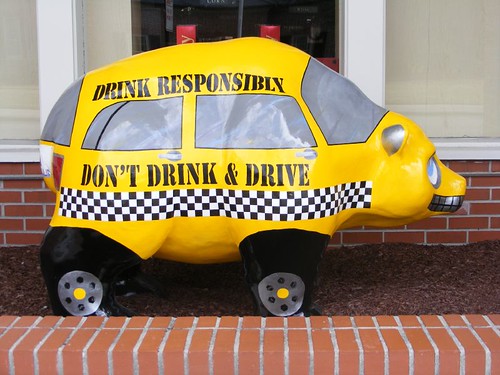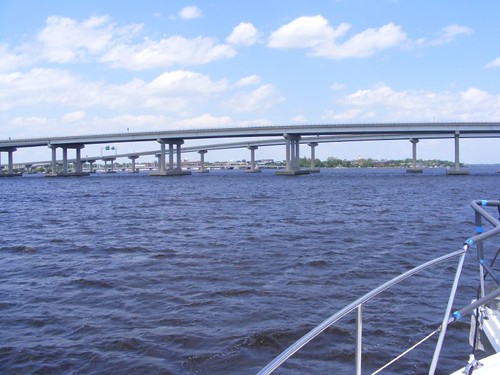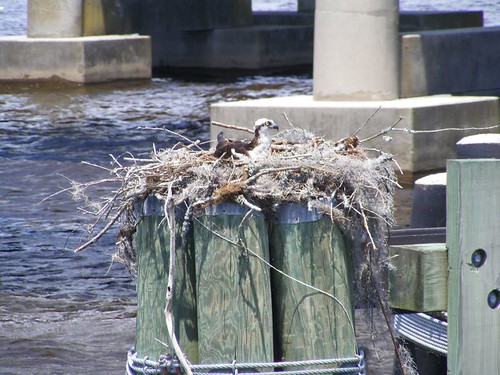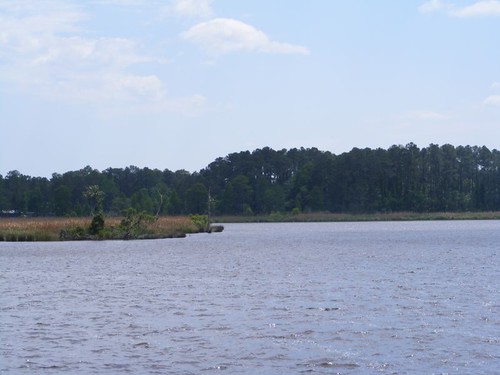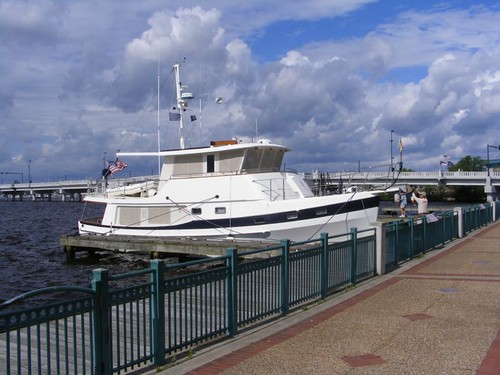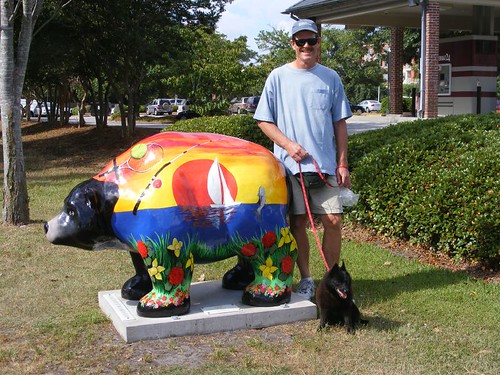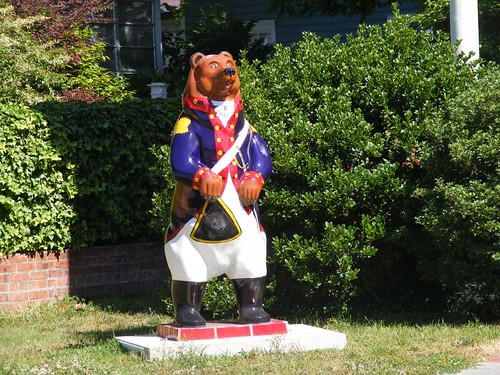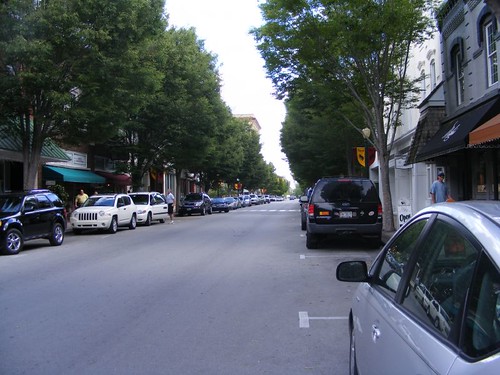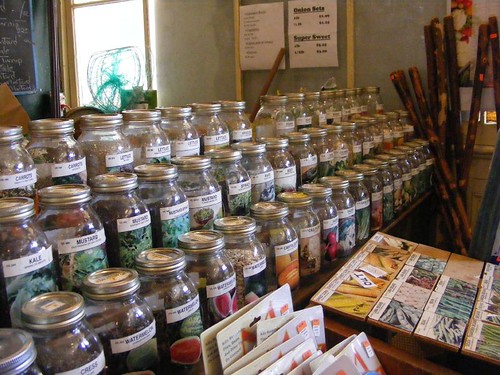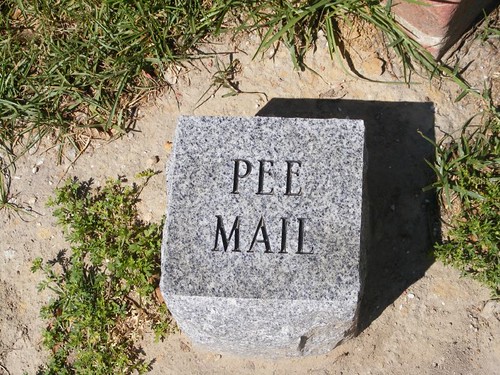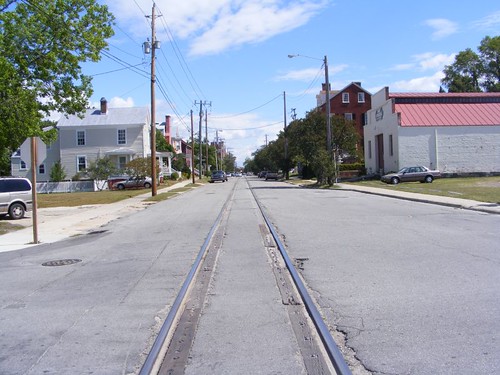May 22 - 24, 2011
Since it was Sunday morning, the S-bridge didn't open up before 8:00 a.m., so we had plenty of time to wake up and get ready to leave our lovely, peaceful swamp. By the time we rounded the bend and had the bridge in sight it was just before 8, so we radioed the bridge to request the first opening. The cheerful operator replied, in one of those friendly Carolina accents, that he had been waiting for us and just to bring her on up and he would open the bridge.
Our trip back down the Perquimans River was uneventful; the action didn't take place until we got back out on Albemarle Sound. We were overtaken by clouds of these midges, mostly ephemeral, nonbiting insects. However, before they mate and die off, they poop a lot and make an awful, green slimy mess. They were all over any lee area on FLUKE, by the thousands!
We passed under a very high set of power lines. These cormorants took advantage of the height and remoteness of the support structure to find safe, affordable housing.
By midday we were pulling into the Edenton, NC town dock. One of the great things about this facility is that you can make online reservations ahead of time. For us, that was critical because FLUKE could only fit on the t-head at the end of the dock because her beam is almost 18'; the slips are designed for narrower boats. There are very few, if any places to anchor in the vicinity, so we would have been stressed to find somewhere to go if we came this far up the Sound without a reservation. The town allows boats two nights at no charge and then additional nights are only $1/ft. 50 amp power is only $6/night and free water is available on the docks. We signed up for 3 nights. Within half an hour a pair of sparrows visited us, filling their beaks with the midges (despite Eddie have rinsed off the boat) on every return trip back to the boat. They picked bugs from everywhere they could, including looking up under the bicycle seats! Obviously we weren't the first buggy boat to land in their town.
The town docks are protected by a large breakwater, a necessity since the whole area is open to the south and the winds blow in with a ferocity that slams the water into, and through the breakwater making lots of noise and even creating quite a bit of water movement within the breakwater. Secure lines and boat fenders are critical and need to be checked frequently.
The town dock area affronts a popular waterfront park, and there are always local people and tourists walking, picnicking, fishing, or just people watching. One of the newest attractions is the Roanoke River lighthouse. The exterior has been restored and is still awaiting some interior finishing before it is placed in its new permanent home, right there on the waterfront.
The lighthouse was originally built in 1887 and was one of the type of many that were used on inland waterways in the area. They were all built on a type of screw pile that elevated them over the water, and this one is believed to be the last of its kind. The lighthouse was decommissioned in 1941 and purchased by a private individual in 1955 to be moved and used as his residence for 50 years. Upon his death, the Edenton Historical Commission purchased the lighthouse to spearhead its very expensive restoration.
In the picture of FLUKE at the dock, the Barker House (1782), home of the Eden Historical Commission, is visible in the background. This is open to the public and is staffed by very friendly volunteers who have a wealth of information about Edenton's history and present day goings on. There are informative historical displays, a gift shop with fabulous books, and to my complete delight, a real screw pile. The FLUKE crew had had discussions about what these might be since we had never heard of them. This one doesn't include the metal casing that would have gone on the tip to help get it into the river bottom.
The Barker House is a great place to sit in one of the rocking chairs and catch a breeze from Edenton Bay and view the lovely waterfront residential homes or read your travel brochure and plan your walking tour of the town.
There is also a Visitor's Information Center located within walking distance in the opposite direction of the waterfront. It is worth a stop so you can see a 15 minute video giving some history of the town's original development and its key citizens and their significance to the country's fight for liberty and independence. The town was incorporated in 1722 and named to honor the recently deceased governor, Charles Eden. Because of having a decent harbor and access to the Atlantic Ocean via Roanoke Inlet, the town flourished as a port of entry and an important trading center and colonial capital with connections to the other American colonies, the West Indies, and England. Goods were shipped in and out providing wealth and jobs to the area. That history is still evidenced today by the many grand homes and churches that are wonderfully preserved. The cemetery at St. Paul's church (1736) has many lavish, artistic tombstones that must have cost a fortune even in their day. I think this is one of the most elaborate; it is located in a private family plot area. Each of the four upper corners has a different face. Notice the intricate stone carving work over the top area. It is built like a gazebo with a female statue standing inside.
Edenton has a bit of political notoriety to its history. In 1774, Mrs. Penelope Barker (the Barker house) organized a group of 51 women to hold what was known as the Eden Tea Party. They had agreed to support their husband's stands on taxation without representation as proof of their patriotism to the cause. They resolved not to drink any more tea or wear any British clothing. Unfortunately, organized women's movements were not in vogue at the time, so were not taken seriously by even their fellow colonists, mostly because they were men who had hang-ups about those activities for women.
Harriet Ann Jacobs, an Edenton black woman born into slavery in 1813 became a writer and abolitionist. In 1842 she escaped to freedom from Edenton via the Maritime Underground Railroad. You can read about her and other people of historical significance on the many information signs located throughout the town.
One of the most photographed dwellings is the Cupola House (1758) because of its distinctive Jacobean-Georgian architecture and beautiful gardens in both the front and back of the house.
Mother Nature, shifting economics, and politics led to Edenton's decline as a commerce center. Roanoke Inlet got silted in by the 1795 hurricane, cutting off the town's ready access to the sea. Opening of the Dismal Swamp Canal in 1805 diverted river commerce to Norfolk. The community opposed railroad development, further hampering jobs and the distribution of goods. Fortunately the Civil War bypassed Edenton, allowing many of the architecturally unique homes and buildings to be preserved in their original state.
Today's main street houses businesses and restaurants in many storefronts from the late 1800s. Bloomingdeals, an upscale consignment shop, proved to be my favorite. We got a delicious pizza from Kristy's, a restaurant specializing in Italian cuisine.
Edenton is home to one of the oldest (1863) fish hatcheries in the U.S. The U.S. Fish & Wildlife Service produces warm water species of shad and striped bass for restocking public areas. When we heard the facility was only 2 miles outside town we decided to ride our bicycles to take a tour.
We sure were surprised to see wheat fields right on the edge of town.
The fish hatchery is open free to the public, and you are on your own to view the buildings and grounds. The main building has aquarium displays with freshwater species of fish found in Eastern North Carolina. The hatchery ponds are in various states of use or maintenance. They are drained to remove the fish for relocation and then left to dry to help reduce disease organisms.
Notice that there are no fenced areas around the ponds so you can walk right up to the edge to look in. People are urged to exercise caution, but are still left to their own accords, with the assumption that they may actually use common sense and not fall in. That trait must be something endemic to this state since we first heard about it with the railroad track situation in New Bern. If that could be marketed for other parts of the country it could help reverse the dumbing down of the population and the need for a Nanny State.
Wetlands preservation and education are a big environmental concern throughout the country. The facility has a short nature trail that lets you take a raised boardwalk through a natural wetland that overlooks Pembroke Creek. There are elevated duck boxes placed on the opposite side of the creek since the facility is part of the North Carolina Birding Trail. Notice the cottony catkins (probably from a poplar) littering the walkway.
The hatchery is also a repository site for oyster shells. They are placed inside big yellow collection bins.
We had one more bike riding adventure not mentioned in any of the tourist information literature. One of the locals who frequents the waterfront told me we should not miss a ride out to Hayes Plantation, the beginning of whose property lies just outside of town. He said to ignore the no trespassing/private property signs by the big gate to the property and take the walking entrance to its side. So, that's what we did early one evening. The Hayes Plantation comprises 1000 acres of land, the whole tip of one peninsula and has been in farming types of various sorts since the colonial days. The paved road goes through forested land, fields of wheat and sage, past the original gatehouse and slave quarters, and ends in a small enclave of private, modern homes (obviously developed to help defray costs of maintaining the plantation). The plantation house is nestled in a heavily treed area and is barely visible from the road. It was great to see the lavender-colored sage fields in the peak of growth and the field irrigator slowly creeping along through the rows. These plants stand about 2' tall and are more fragrant flowers than leaf material. The ladies at the Barker House had told me that sage is a modern day crop profitable for use in the perfume industry. Bluebird boxes are set amidst the roadside brush, and I got to see a pair of bluebirds! I am a strong advocate of taking the road less traveled in case you haven't guessed that by now.
You will see that last thought reflected in the next chapter too.
Saying goodbye from a nice spot on Pembroke Creek, I am
Sunday, May 29, 2011
Friday, May 27, 2011
The land of beautiful women
May 20 – 22, 2011
Our first detour off Albemarle Sound, on May 20, was 12 miles up the Perquimans River to the small town of Hertford. The Yeopim Indians named the river area, and the white translation means land of beautiful women. Ursa and FLUKE were going to the right place! The whole area could also be called the land of beautiful trees and waters.
Right before you get to the beginning of the Hertford community, you have to go under a bridge with only 34' of clearance. So, a lot of sailboats cannot get under and don't want to have to anchor out as far from the town landing, so they don't make Hertford part of their cruising plans. Most power boaters would be able to get under the bridge, but there are no docking facilities so they don't stop at Hertford either. We had a concern about getting under the bridge since we think we need 30' to clear, so Eddie stood on the roof and Wayne eased FLUKE slowly under the bridge to make sure our mast wouldn't hit the bridge or the signal lights that hang lower under the bridge.
A smile came upon our faces when we rounded the point and saw the unique concrete and steel S-shaped swing bridge abutting the quaint waterfront area. We would learn that this bridge is the only one of its kind in the U.S. and the town is divided over the possibility of having to replace it. I took this picture of an aerial photograph that I saw at the Chamber of Commerce/Visitor's Center. It gives a good idea of how the bridge gets its name.
After we passed through the bridge we slowly passed the town waterfront area, went around one more bend and ended up in a wide spot in the river surrounded by a beautiful cypress swamp. This was just our perfect kind of place to drop the anchor. We had the place all to ourselves except for the osprey nesting in a huge cypress tree that stood alone out in the water about 50 yards from FLUKE. One resident told us that an osprey nests there every year.
Since it was late afternoon we decided to get Scooter (that's what I've decided to call our new, little dinghy) pumped up and ready to launch the next morning when we would take a land tour. Bass fisherman were coming in from their day of fishing, some with very fancy, glittery-painted boats traveling on plane at 50mph, but creating little wake since there wasn't much of the boat in the water; they were riding on air! Our biggest surprise came right as the sun turned out the lights. The night became alive with a cacophony of millions of frogs croaking trying to be louder than the din of all the insects that they hoped to feast upon. If you listened closely you could hear the unmistakable hoot of a great horned owl.
You can't tell from the photo, but we are anchored within site of the "causeway" road that connects to the S-bridge that everyone entering or leaving town has to use. So, as we were walking around town, several of the locals inquired about who we were, and then had a lot of questions when they found out we were from "that" boat. A couple of them said how much they enjoyed seeing a boat like FLUKE anchored within sight.
When we were dinghying into the town landing, we passed by a river camping platform. There are several of these scattered along the banks of the Perquimans River so that people traveling in canoes and kayaks have a solid place to land and camp for the night.
There are two good public places available for landing a dinghy: the town boat ramp and Missing Mill Park. Both of them are easily visible from the water. We chose the town boat ramp because it is on a floating dock in a no wake zone. There are no cleats to use, so you have to try to use a piling and run a line through the dock boards, which were covered with a lot of duck poop. We shared the space with a kayaker who was pulling out his kayak and we were able to drill him with a bunch of questions and get some local information.
Eddie and I went into the Visitor's Center building to get a walking tour map and do some more information gathering. You can easily do the walking tour within a half day's time. The tree-lined streets have sidewalks, and the houses have little signs out front with their names and dates of origin. Quakers played an early role in settling the area, but as other settlers moved in they brought more money and built homes in the Queen Anne and Colonial Revival style that are well-preserved and have helped put Hertford on the National Historic Register of Historic Places. Residents take pride in their homes and gardens as evidenced by how well they are kept up and the diversity of gardens. Magnolias and Confederate jasmine were in full bloom; their fragrances permeated the air as we walked along the streets.
We were admiring one truly outstanding garden whose owners were sitting on one of the garden benches. We said hello and commented about the uniqueness and beauty of their garden: it was a combination of flowers, ornamentals, and bedded vegetables. There was a sticker that said “Save Our Bridge”, so we asked them about that. Frank and Connie invited us in to hear their story and answer the other hundred questions we had. They were on a committee to try to save the S-bridge so it was interesting to hear about both sides of the controversy. Frank had worked in England for a number of years and brought back this 2000# genuine British iron telephone booth.
Since Frank and Connie's lovely waterfront home is only one door away from the S-bridge we could easily hear the bell ringing indicating the bridge was going to open. We wanted to be right up on the bridge by the tender's house when it opened so we could see how everything worked, so we said our thank yous and headed up to the bridge. When the operation was completed, the friendly tender opened the door to ask where we were from. I peaked in and asked if I could take a photo of the control area since all we ever get to see is the underside of the bridges and the outside of the control house.
The “business” district is really only on about a street and a half. The 1825 Federal style courthouse building still functions as the present Perquimans County Courthouse. Several other small businesses occupy other originally built structures from the 1800s. This large mural shows a bit of the long past and recent heritage of the area.
Wayne and Ursa were sitting outside the hardware store where this mural was located. A black man in his 60s was fascinated by Ursa (she is REALLY a man magnet) and asked Wayne several questions about her, including “Is she a boy or a girl?”. When Wayne told him that Ursa was a girl he smiled and said “Well, black girls really like me!”
Eddie and I browsed a few of the small shops, including a kind of 5 and 10 store that has been in continuous operation by the same family for almost 100 years. The friendly owner, about our age, showed us pictures of days gone by when penny candy was sold in large display bins and their sale rang up with the same cash register she still is using today. She also shed light on why we had seen so many turtle knickknacks in store windows and even on the town seal. She said her grandmother talked about the gigantic cypress log that is partially submerged by the causeway road into town where turtles bask in the sun still to this day welcoming strangers to their quaint community.
Since it was getting close to lunch time, the FLUKE crew needed to engage in some food foraging action. We saw a sign at one of the churches advertising a fish fry youth fund raising sale. We picked up some fish dinners and walked over to Missing Mill Park, adjacent to the river front where we could see FLUKE at anchor a ways upriver. The well-used park, with its scenic view, gets its name from having been the former site of a cotton seed oil mill. Since several of the locals had told us not to pass up hand dipped ice cream from Woodard's Pharmacy we walked back uptown to the soda fountain area inside the drug store to special order our “drugs”. You can't beat the price: $.60 for an 8 oz. scoop! Having gotten our daily sugar fix, we licked our lips and wiped our fingers and happily went on our way.
Our day on the swamp would end with some special guests. Frank and Connie had mentioned that they would be going to a benefit garden party for the Perquimans County Historical Preservation Society that would take them right by us since they would be going via pontoon boat. The host of the party actually brought his boat down river to FLUKE to invite us to the event. While we graciously declined his offer, when the pontoon boat crew came by, we invited them all aboard for a tour. The party theme was Alice in Wonderland, and the ladies were encouraged to wear hats. This group was the best dressed guests we have ever had aboard. Eldon, the gentleman sitting in the back right of the boat (next to the beer bottle), is 91. Wayne found him climbing down the back ladder from the upper deck!
We didn't see the White Rabbit checking his watch that night, but the other inhabitant's of the swamp garden lulled us to sleep with their nightly chorus.
Our next stop would take us to another garden party further up the Albemarle Sound.
Our first detour off Albemarle Sound, on May 20, was 12 miles up the Perquimans River to the small town of Hertford. The Yeopim Indians named the river area, and the white translation means land of beautiful women. Ursa and FLUKE were going to the right place! The whole area could also be called the land of beautiful trees and waters.
Right before you get to the beginning of the Hertford community, you have to go under a bridge with only 34' of clearance. So, a lot of sailboats cannot get under and don't want to have to anchor out as far from the town landing, so they don't make Hertford part of their cruising plans. Most power boaters would be able to get under the bridge, but there are no docking facilities so they don't stop at Hertford either. We had a concern about getting under the bridge since we think we need 30' to clear, so Eddie stood on the roof and Wayne eased FLUKE slowly under the bridge to make sure our mast wouldn't hit the bridge or the signal lights that hang lower under the bridge.
A smile came upon our faces when we rounded the point and saw the unique concrete and steel S-shaped swing bridge abutting the quaint waterfront area. We would learn that this bridge is the only one of its kind in the U.S. and the town is divided over the possibility of having to replace it. I took this picture of an aerial photograph that I saw at the Chamber of Commerce/Visitor's Center. It gives a good idea of how the bridge gets its name.
After we passed through the bridge we slowly passed the town waterfront area, went around one more bend and ended up in a wide spot in the river surrounded by a beautiful cypress swamp. This was just our perfect kind of place to drop the anchor. We had the place all to ourselves except for the osprey nesting in a huge cypress tree that stood alone out in the water about 50 yards from FLUKE. One resident told us that an osprey nests there every year.
Since it was late afternoon we decided to get Scooter (that's what I've decided to call our new, little dinghy) pumped up and ready to launch the next morning when we would take a land tour. Bass fisherman were coming in from their day of fishing, some with very fancy, glittery-painted boats traveling on plane at 50mph, but creating little wake since there wasn't much of the boat in the water; they were riding on air! Our biggest surprise came right as the sun turned out the lights. The night became alive with a cacophony of millions of frogs croaking trying to be louder than the din of all the insects that they hoped to feast upon. If you listened closely you could hear the unmistakable hoot of a great horned owl.
You can't tell from the photo, but we are anchored within site of the "causeway" road that connects to the S-bridge that everyone entering or leaving town has to use. So, as we were walking around town, several of the locals inquired about who we were, and then had a lot of questions when they found out we were from "that" boat. A couple of them said how much they enjoyed seeing a boat like FLUKE anchored within sight.
When we were dinghying into the town landing, we passed by a river camping platform. There are several of these scattered along the banks of the Perquimans River so that people traveling in canoes and kayaks have a solid place to land and camp for the night.
There are two good public places available for landing a dinghy: the town boat ramp and Missing Mill Park. Both of them are easily visible from the water. We chose the town boat ramp because it is on a floating dock in a no wake zone. There are no cleats to use, so you have to try to use a piling and run a line through the dock boards, which were covered with a lot of duck poop. We shared the space with a kayaker who was pulling out his kayak and we were able to drill him with a bunch of questions and get some local information.
Eddie and I went into the Visitor's Center building to get a walking tour map and do some more information gathering. You can easily do the walking tour within a half day's time. The tree-lined streets have sidewalks, and the houses have little signs out front with their names and dates of origin. Quakers played an early role in settling the area, but as other settlers moved in they brought more money and built homes in the Queen Anne and Colonial Revival style that are well-preserved and have helped put Hertford on the National Historic Register of Historic Places. Residents take pride in their homes and gardens as evidenced by how well they are kept up and the diversity of gardens. Magnolias and Confederate jasmine were in full bloom; their fragrances permeated the air as we walked along the streets.
We were admiring one truly outstanding garden whose owners were sitting on one of the garden benches. We said hello and commented about the uniqueness and beauty of their garden: it was a combination of flowers, ornamentals, and bedded vegetables. There was a sticker that said “Save Our Bridge”, so we asked them about that. Frank and Connie invited us in to hear their story and answer the other hundred questions we had. They were on a committee to try to save the S-bridge so it was interesting to hear about both sides of the controversy. Frank had worked in England for a number of years and brought back this 2000# genuine British iron telephone booth.
Since Frank and Connie's lovely waterfront home is only one door away from the S-bridge we could easily hear the bell ringing indicating the bridge was going to open. We wanted to be right up on the bridge by the tender's house when it opened so we could see how everything worked, so we said our thank yous and headed up to the bridge. When the operation was completed, the friendly tender opened the door to ask where we were from. I peaked in and asked if I could take a photo of the control area since all we ever get to see is the underside of the bridges and the outside of the control house.
The “business” district is really only on about a street and a half. The 1825 Federal style courthouse building still functions as the present Perquimans County Courthouse. Several other small businesses occupy other originally built structures from the 1800s. This large mural shows a bit of the long past and recent heritage of the area.
Wayne and Ursa were sitting outside the hardware store where this mural was located. A black man in his 60s was fascinated by Ursa (she is REALLY a man magnet) and asked Wayne several questions about her, including “Is she a boy or a girl?”. When Wayne told him that Ursa was a girl he smiled and said “Well, black girls really like me!”
Eddie and I browsed a few of the small shops, including a kind of 5 and 10 store that has been in continuous operation by the same family for almost 100 years. The friendly owner, about our age, showed us pictures of days gone by when penny candy was sold in large display bins and their sale rang up with the same cash register she still is using today. She also shed light on why we had seen so many turtle knickknacks in store windows and even on the town seal. She said her grandmother talked about the gigantic cypress log that is partially submerged by the causeway road into town where turtles bask in the sun still to this day welcoming strangers to their quaint community.
Since it was getting close to lunch time, the FLUKE crew needed to engage in some food foraging action. We saw a sign at one of the churches advertising a fish fry youth fund raising sale. We picked up some fish dinners and walked over to Missing Mill Park, adjacent to the river front where we could see FLUKE at anchor a ways upriver. The well-used park, with its scenic view, gets its name from having been the former site of a cotton seed oil mill. Since several of the locals had told us not to pass up hand dipped ice cream from Woodard's Pharmacy we walked back uptown to the soda fountain area inside the drug store to special order our “drugs”. You can't beat the price: $.60 for an 8 oz. scoop! Having gotten our daily sugar fix, we licked our lips and wiped our fingers and happily went on our way.
Our day on the swamp would end with some special guests. Frank and Connie had mentioned that they would be going to a benefit garden party for the Perquimans County Historical Preservation Society that would take them right by us since they would be going via pontoon boat. The host of the party actually brought his boat down river to FLUKE to invite us to the event. While we graciously declined his offer, when the pontoon boat crew came by, we invited them all aboard for a tour. The party theme was Alice in Wonderland, and the ladies were encouraged to wear hats. This group was the best dressed guests we have ever had aboard. Eldon, the gentleman sitting in the back right of the boat (next to the beer bottle), is 91. Wayne found him climbing down the back ladder from the upper deck!
We didn't see the White Rabbit checking his watch that night, but the other inhabitant's of the swamp garden lulled us to sleep with their nightly chorus.
Our next stop would take us to another garden party further up the Albemarle Sound.
Thursday, May 26, 2011
Heading to the Backwaters
May 18-19, 2011
The Neuse River connects into Pamlico Sound. Pamlico Sound is connected to Albemarle Sound, our next destination, by the Pungo River, Alligator River-Pungo River Canal, and the Alligator River. Going through the rivers and canals is usually a leisurely cruise for the greatest part since the waters are protected by fragrant pine forests and golden marsh lands on either side.
Just outside the backwoods, shrimping town of Hobucken (got to love that name!) there is a bulkhead along the waterway that looks like a barge would be able to pull up to it. In this photo you can see some big piles of oyster shells, literally tons of them. They are shells from locally caught and shucked oysters that will be picked up by a barge and taken back out to the oyster bed areas so that there will be a substrate and "seed" bed for the newly hatched oysters to attach themselves to. That is the ultimate in recycling and protecting a valuable resource.
The run from where we started up the Neuse River all the way to the Alligator River was more than we wanted to make in a day, so we stopped just off the Pungo River for the night. It was still kind of windy, but I guess we are getting used to that, so we weren't uncomfortable. Plus, we finally had a pretty sunset since the overcast skies were beginning to clear up a bit.
As you are heading north along the ICW, the run through the AP Canal is a mix of some rural homesites and natural swamp vegetation. This is the earliest we have ever gone through the area and it was just alive with so much bird activity, from big birds like ospreys and eagles to a gazillion song birds who were chattering madly in the trees. I've written before about the birds and stumps and how I like the transit except if one of the big barges is having to pass by and then it gets a bit scary since you don't know for sure if you are going to run over any of those wicked stumps. Also, floating logs can be a hazard. This photo shows one of the big piles we passed; they are removed by waterway maintenance workers since they are considered hazards to navigation. I don't know if the piles are eventually picked up or maybe burned in place. I wouldn't be surprised if they are allowed to be removed by a private enterprise since most of them are valuable cypress logs or hardwoods which are no longer permitted to be harvested in that area.
A big part of this area is bordered on the east side by the Alligator River National Wildlife Refuge, so the fascinating flora and fauna of this unique area are afforded protection. While we have seen deer in this area, we haven't had the privilege of seeing any black bear, or even better yet, a red wolf. The wolves were reintroduced into the area because of its remoteness and also because it is surrounded completely by water. Despite being so isolated, I find it amusing that we still see "advertising" signs.
The Dismal Swamp route is one choice boaters can take after they exit the Alligator River. You have to go through Elizabeth City for that, so they are always trying to get cruisers to take that route and bring some business to their delightful community. We did that once and WILL NEVER do it again in a fat bottomed boat like FLUKE. You can look back in the archives for my description of that miserable adventure. In fact, I think the AP canal/rivers swamp tour is much better than the Dismal anyway.
Remember how when you were a kid having to take long care rides and come up with ideas for entertainment if the scenery became too boring, like what happens along the interstate? The same thing can happen on a cruise like this when we are on wide open rivers, far from shore and there isn't any other boating traffic. Eddie comes up with some creative diversions.
The ride north on the ICW leads to the Alligator River swing bridge. The bridge will not open if the winds exceed 34 knots, and if you are stuck on the south side there is really no marine facilities close by, so you would have to anchor in the swamp.
Right after we passed through the bridge we decided to pull to the side of the ICW, just short of the Little Alligator River which empties into the Alligator River. We have learned that this is the start of blue crab fishing season. There are more crab trap floats than we have ever seen before, so we have to be careful threading our way through the maze of floats and hoping we don't get one hung up in our prop or on one of our stabilizer fins. When we find a place to anchor we have to make sure that if we swing around in the night we won't wind up swinging through a series of crab traps. I liked the name of this crab boat!
Coming up: The FLUKE crew takes another detour into uncharted waters: west up the Albemarle Sound.
The Neuse River connects into Pamlico Sound. Pamlico Sound is connected to Albemarle Sound, our next destination, by the Pungo River, Alligator River-Pungo River Canal, and the Alligator River. Going through the rivers and canals is usually a leisurely cruise for the greatest part since the waters are protected by fragrant pine forests and golden marsh lands on either side.
Just outside the backwoods, shrimping town of Hobucken (got to love that name!) there is a bulkhead along the waterway that looks like a barge would be able to pull up to it. In this photo you can see some big piles of oyster shells, literally tons of them. They are shells from locally caught and shucked oysters that will be picked up by a barge and taken back out to the oyster bed areas so that there will be a substrate and "seed" bed for the newly hatched oysters to attach themselves to. That is the ultimate in recycling and protecting a valuable resource.
The run from where we started up the Neuse River all the way to the Alligator River was more than we wanted to make in a day, so we stopped just off the Pungo River for the night. It was still kind of windy, but I guess we are getting used to that, so we weren't uncomfortable. Plus, we finally had a pretty sunset since the overcast skies were beginning to clear up a bit.
As you are heading north along the ICW, the run through the AP Canal is a mix of some rural homesites and natural swamp vegetation. This is the earliest we have ever gone through the area and it was just alive with so much bird activity, from big birds like ospreys and eagles to a gazillion song birds who were chattering madly in the trees. I've written before about the birds and stumps and how I like the transit except if one of the big barges is having to pass by and then it gets a bit scary since you don't know for sure if you are going to run over any of those wicked stumps. Also, floating logs can be a hazard. This photo shows one of the big piles we passed; they are removed by waterway maintenance workers since they are considered hazards to navigation. I don't know if the piles are eventually picked up or maybe burned in place. I wouldn't be surprised if they are allowed to be removed by a private enterprise since most of them are valuable cypress logs or hardwoods which are no longer permitted to be harvested in that area.
A big part of this area is bordered on the east side by the Alligator River National Wildlife Refuge, so the fascinating flora and fauna of this unique area are afforded protection. While we have seen deer in this area, we haven't had the privilege of seeing any black bear, or even better yet, a red wolf. The wolves were reintroduced into the area because of its remoteness and also because it is surrounded completely by water. Despite being so isolated, I find it amusing that we still see "advertising" signs.
The Dismal Swamp route is one choice boaters can take after they exit the Alligator River. You have to go through Elizabeth City for that, so they are always trying to get cruisers to take that route and bring some business to their delightful community. We did that once and WILL NEVER do it again in a fat bottomed boat like FLUKE. You can look back in the archives for my description of that miserable adventure. In fact, I think the AP canal/rivers swamp tour is much better than the Dismal anyway.
Remember how when you were a kid having to take long care rides and come up with ideas for entertainment if the scenery became too boring, like what happens along the interstate? The same thing can happen on a cruise like this when we are on wide open rivers, far from shore and there isn't any other boating traffic. Eddie comes up with some creative diversions.
The ride north on the ICW leads to the Alligator River swing bridge. The bridge will not open if the winds exceed 34 knots, and if you are stuck on the south side there is really no marine facilities close by, so you would have to anchor in the swamp.
Right after we passed through the bridge we decided to pull to the side of the ICW, just short of the Little Alligator River which empties into the Alligator River. We have learned that this is the start of blue crab fishing season. There are more crab trap floats than we have ever seen before, so we have to be careful threading our way through the maze of floats and hoping we don't get one hung up in our prop or on one of our stabilizer fins. When we find a place to anchor we have to make sure that if we swing around in the night we won't wind up swinging through a series of crab traps. I liked the name of this crab boat!
Coming up: The FLUKE crew takes another detour into uncharted waters: west up the Albemarle Sound.
Monday, May 23, 2011
FLUKE on the Neuse
May 13 – 17, 2011
When we last left you we were headed to the South River anchorage off the Neuse River in North Carolina. After getting the anchor down securely and getting buzzed by a couple of curious hummingbirds, we spent 3 nights there, just trying to catch up on some much-needed rest and getting FLUKE back in order. The weather forecast remained very windy with a constant threat of thunderstorms. It was clear that if we hadn't made it in to Beaufort when we did, we wouldn't have made it to North Carolina for several more days; the fleet would have had to go into another inlet to the south.
The days went by with the wind howling outside and dark skies looming overhead, but we were so busy it was never boring and time passed quickly. Wayne caught up on some baking: English muffins, hot dog and hamburger buns. FLUKE smelled great!
We were anchored across from an old cemetery that used to belong to the long ago abandoned community of Lukens. On Saturday morning I heard a motor sound and I looked out the window to see a small, home-made, barge-like vessel being pushed by a fishing boat. There were a dozen people on the barge with lawn mowers, coolers, and tools. They all headed over to the cemetery. I could look through the binoculars and see them working among the scattered headstones, cleaning up the grounds.
The Neuse River is one of the widest (6 miles) rivers in the U.S. and it is 34 miles long. We decided to cruise all the way up to New Bern, about 25 miles. New Bern was founded by a group of German and Swiss colonists in the 1700's, thus the European name. The city prospered as a riverfront community and was both the colonial and state capital for a period of time. Today, there still remain many fine homes and buildings from the 17 and 1800's with a revitalized, charming downtown business district within easy walking distance from the waterfront.
Coming up the river and seeing the expansive bridges is quite an impressive site when you are expecting to see an historic waterfront community. We had decided to anchor a couple of miles up the Trent River which intersects the Neuse River right at New Bern's waterfront hub. That meant we had to go under the big spanning bridges, through a low, bascule bridge which opened on demand for us at the time of day we were passing through, and then we had to go through a swing railroad bridge with 32' of opening width on each side which looks pretty narrow when you are at the helm of a fat 18' wide girl like FLUKE. Then under another set of 3 bridges and into a more quiet section of the Trent River.
Most of the channel markers and pilings were occupied by nesting ospreys, and some of them were at our eye level. I wonder why this osprey chose to live right under a noisy, busy bridge when the wilds are in sight a short distance away. You can see the variety of nesting materials in this photo.
The scenery changed from business to residential in a hurry. In less than 2 miles, we were in a section of diverse types of private homes and vacant marsh.
We found a secure, roomy place to drop the anchor and spent the rest of the afternoon planning for the next day's activities, doing boat chores, and food preparation. I watched a pair of Canada geese swim slowly by with a flock of newly borne chicks trailing closely behind. They were still so tiny and very yellow; I think it was the first time they had crossed the river. Cows were mooing through the trees nearby. A bald eagle flew low overhead, making the geese honk madly and several ospreys screeched and flew after it, pecking at its tail. As night settled in, the water looked like black glass with a big moon reflecting off its surface and a pleasant cool, quiet settled over the marsh. Perfect conditions for a good night's sleep!
We wanted to get to the town dock early before the wind had a chance to kick up and make it more difficult to get to the dock. When we had gone through the bascule bridge the day before we noticed a sign that said the bridge was closed for recreational boat traffic from 6:30 a.m. - 8:30 a.m., but had an opening at 7:30 a.m., so that's what we decided to go for.
We noticed that the docks were shorter (only 40') than FLUKE, so that presented a challenge to be able to adequately tie her up. Wayne pulled up perpendicular to the end of the dock to let me jump off the boat and start grabbing lines while he slowly eased FLUKE in. I would secure the line to the dock and Eddie would tie it off to the boat and try to pull the boat in.
In addition to being too short for us, the docks are really exposed to the wind and open water conditions. We were tentative about how much FLUKE would shift with changing weather conditions, but decided to go for a walk in the downtown area which was close by anyway. It had been a full week now since we had been off FLUKE, so it felt good to be back on terra firma for some walking exercise. It is funny, though, how we still felt we were “on the boat” as we walked around with a bit of a rubbery leg feel.
The New Bern community had a display of theme-decorated bears placed throughout the downtown area; the opening photo was one that was in front of a liquor store. Here are a couple more of my favorites.
New Bern is a pleasant town to walk around. The tree-lined streets have interesting shops of all sorts housed in architecturally fascinating buildings from a bygone era. Several of the shops had water bowls for dogs. A dog-friendly town is our kind of town!
We found a corner drugstore next to this historical information sign. Since we all drink Diet Pepsi we were interested in seeing what was inside. There were all kinds of Pepsi memorabilia and an old-fashioned soda fountain. One of the tee shirts for sale said “Friends don't let friends drink Coke”.
The best commercial visit was to Mitchell's Hardware store. The placard in the doorstep read 1911. The store was packed with all kinds of merchandise like you would find at a country general store. Locally grown bedding flowers and vegetables lined the sidewalk outside the store. Employees were cheerful and attentive to the many customers who were browsing. Ursa was a huge hit with the staff and other customers when one of the employees asked if she could give Ursa a treat. We told her that she could, but only if she made Ursa do tricks. Ursa works for anyone with food, so we just told her to think of things to tell Ursa to do and Ursa did a half dozen tricks for her. I finally managed to find a heat diffuser for our gas burners; I hadn't been able to find one at any of the big box stores before we left the home port.
The residential neighborhood is adjacent to the business district and the tree-lined streets are filled with a variety of period homes, many in beautifully restored condition. Modern updates have not been ignored for our canine friends either, as evidenced by this corner yard monument we passed. Ursa made a good connection and picked up, and left, appropriate communications.
One of the biggest tour highlights for the town is Tryon Palace Historic Site & Gardens. The palace was built by Governor Tryon in the 1700s and was damaged by fire, but has been restored to the original specifications. Several outlying buildings of historical significance are on streets adjacent to the palace grounds. Most all the buildings have gardens of varying sorts and sizes. We didn't have time to tour anything inside, but it was interesting walking around the outside, seeing the buildings and their grounds.
At the beginning of this post I told you that we had to go through a railroad bridge. Well, we saw where the tracks left the waterfront area and were so surprised to see that they go right through the town. The cross streets don't have any crossing gates, and you can see in this photo that cars just drive right down the middle of the tracks when there isn't a train there. We found it amazing to find that the New Bern residents actually assume personal responsibility for dealing with the train passing through their town and having sense enough to know to stay off the tracks without having a government agency tell them how to do it.
As midday was approaching and the weather was deteriorating with the winds picking up and the skies darkening, we decided we had better head back to FLUKE. We walked back via the Riverwalk which runs right along the waterfront. This is a modern, walk area that connects the convention center, hotels, and marinas. It has been landscaped with native vegetation and has lots of information signs about coastal fauna and flora. This mallard mother brought her babies in close to teach them how to receive subsidies from an early age. She lost interest when she realized that we didn't work for the government!
When we got back to the town dock, we had an unpleasant surprise. With the wind blowing hard in, FLUKE had stretched her lines enough such that the bow was scraping the dock. Now we have a smudged “nose” that will need a paint make-over. At least the fiberglass was not chipped.
It wasn't going to be an easy task to get safely off the dock. At least we were the only boat there, so we didn't have to worry about hitting another boat. We had a crew meeting to figure out how to release the lines, power the boat up enough to get away from the dock, and to get Eddie back aboard since he was going to be on the dock releasing the lines. In the meantime, it started to rain. So, we scrambled, yelled, and powered up FLUKE.
Unfortunately since I was occupied with line handling I couldn't get a picture of Eddie clinging to the upper deck railing and trying to get a toe hold on the rubrail while we were pulling away from the dock and he was jumping off the dock. He'll be 70 in December, but he can still climb like a monkey!
Our adventure on the Neuse River ends at Clubfoot Creek. No, I didn't name it that because Eddie left a toe behind in New Bern when we left the dock. I've told you before, the origin of some of these names is only a part of local folklore that would take a lot to try to uncover. This isolated, tree-lined creek provided us a safe haven for the night with the predicted wind direction. For some reason, it took us two tries to get the anchor to set. Clubfoot Creek is not too far from the Cherry Point military base, so we were treated to several flyovers from a variety of military aircraft: jets, helicopters, and transport planes.
We awoke the following morning to glassy waters and a big alligator cruising along the shoreline. Any wildlife siting is a good start to my day.
Stay tuned for our next new adventure: north to Albemarle Sound and west to the Perquimans River.
When we last left you we were headed to the South River anchorage off the Neuse River in North Carolina. After getting the anchor down securely and getting buzzed by a couple of curious hummingbirds, we spent 3 nights there, just trying to catch up on some much-needed rest and getting FLUKE back in order. The weather forecast remained very windy with a constant threat of thunderstorms. It was clear that if we hadn't made it in to Beaufort when we did, we wouldn't have made it to North Carolina for several more days; the fleet would have had to go into another inlet to the south.
The days went by with the wind howling outside and dark skies looming overhead, but we were so busy it was never boring and time passed quickly. Wayne caught up on some baking: English muffins, hot dog and hamburger buns. FLUKE smelled great!
We were anchored across from an old cemetery that used to belong to the long ago abandoned community of Lukens. On Saturday morning I heard a motor sound and I looked out the window to see a small, home-made, barge-like vessel being pushed by a fishing boat. There were a dozen people on the barge with lawn mowers, coolers, and tools. They all headed over to the cemetery. I could look through the binoculars and see them working among the scattered headstones, cleaning up the grounds.
The Neuse River is one of the widest (6 miles) rivers in the U.S. and it is 34 miles long. We decided to cruise all the way up to New Bern, about 25 miles. New Bern was founded by a group of German and Swiss colonists in the 1700's, thus the European name. The city prospered as a riverfront community and was both the colonial and state capital for a period of time. Today, there still remain many fine homes and buildings from the 17 and 1800's with a revitalized, charming downtown business district within easy walking distance from the waterfront.
Coming up the river and seeing the expansive bridges is quite an impressive site when you are expecting to see an historic waterfront community. We had decided to anchor a couple of miles up the Trent River which intersects the Neuse River right at New Bern's waterfront hub. That meant we had to go under the big spanning bridges, through a low, bascule bridge which opened on demand for us at the time of day we were passing through, and then we had to go through a swing railroad bridge with 32' of opening width on each side which looks pretty narrow when you are at the helm of a fat 18' wide girl like FLUKE. Then under another set of 3 bridges and into a more quiet section of the Trent River.
Most of the channel markers and pilings were occupied by nesting ospreys, and some of them were at our eye level. I wonder why this osprey chose to live right under a noisy, busy bridge when the wilds are in sight a short distance away. You can see the variety of nesting materials in this photo.
The scenery changed from business to residential in a hurry. In less than 2 miles, we were in a section of diverse types of private homes and vacant marsh.
We found a secure, roomy place to drop the anchor and spent the rest of the afternoon planning for the next day's activities, doing boat chores, and food preparation. I watched a pair of Canada geese swim slowly by with a flock of newly borne chicks trailing closely behind. They were still so tiny and very yellow; I think it was the first time they had crossed the river. Cows were mooing through the trees nearby. A bald eagle flew low overhead, making the geese honk madly and several ospreys screeched and flew after it, pecking at its tail. As night settled in, the water looked like black glass with a big moon reflecting off its surface and a pleasant cool, quiet settled over the marsh. Perfect conditions for a good night's sleep!
We wanted to get to the town dock early before the wind had a chance to kick up and make it more difficult to get to the dock. When we had gone through the bascule bridge the day before we noticed a sign that said the bridge was closed for recreational boat traffic from 6:30 a.m. - 8:30 a.m., but had an opening at 7:30 a.m., so that's what we decided to go for.
We noticed that the docks were shorter (only 40') than FLUKE, so that presented a challenge to be able to adequately tie her up. Wayne pulled up perpendicular to the end of the dock to let me jump off the boat and start grabbing lines while he slowly eased FLUKE in. I would secure the line to the dock and Eddie would tie it off to the boat and try to pull the boat in.
In addition to being too short for us, the docks are really exposed to the wind and open water conditions. We were tentative about how much FLUKE would shift with changing weather conditions, but decided to go for a walk in the downtown area which was close by anyway. It had been a full week now since we had been off FLUKE, so it felt good to be back on terra firma for some walking exercise. It is funny, though, how we still felt we were “on the boat” as we walked around with a bit of a rubbery leg feel.
The New Bern community had a display of theme-decorated bears placed throughout the downtown area; the opening photo was one that was in front of a liquor store. Here are a couple more of my favorites.
New Bern is a pleasant town to walk around. The tree-lined streets have interesting shops of all sorts housed in architecturally fascinating buildings from a bygone era. Several of the shops had water bowls for dogs. A dog-friendly town is our kind of town!
We found a corner drugstore next to this historical information sign. Since we all drink Diet Pepsi we were interested in seeing what was inside. There were all kinds of Pepsi memorabilia and an old-fashioned soda fountain. One of the tee shirts for sale said “Friends don't let friends drink Coke”.
The best commercial visit was to Mitchell's Hardware store. The placard in the doorstep read 1911. The store was packed with all kinds of merchandise like you would find at a country general store. Locally grown bedding flowers and vegetables lined the sidewalk outside the store. Employees were cheerful and attentive to the many customers who were browsing. Ursa was a huge hit with the staff and other customers when one of the employees asked if she could give Ursa a treat. We told her that she could, but only if she made Ursa do tricks. Ursa works for anyone with food, so we just told her to think of things to tell Ursa to do and Ursa did a half dozen tricks for her. I finally managed to find a heat diffuser for our gas burners; I hadn't been able to find one at any of the big box stores before we left the home port.
The residential neighborhood is adjacent to the business district and the tree-lined streets are filled with a variety of period homes, many in beautifully restored condition. Modern updates have not been ignored for our canine friends either, as evidenced by this corner yard monument we passed. Ursa made a good connection and picked up, and left, appropriate communications.
One of the biggest tour highlights for the town is Tryon Palace Historic Site & Gardens. The palace was built by Governor Tryon in the 1700s and was damaged by fire, but has been restored to the original specifications. Several outlying buildings of historical significance are on streets adjacent to the palace grounds. Most all the buildings have gardens of varying sorts and sizes. We didn't have time to tour anything inside, but it was interesting walking around the outside, seeing the buildings and their grounds.
At the beginning of this post I told you that we had to go through a railroad bridge. Well, we saw where the tracks left the waterfront area and were so surprised to see that they go right through the town. The cross streets don't have any crossing gates, and you can see in this photo that cars just drive right down the middle of the tracks when there isn't a train there. We found it amazing to find that the New Bern residents actually assume personal responsibility for dealing with the train passing through their town and having sense enough to know to stay off the tracks without having a government agency tell them how to do it.
As midday was approaching and the weather was deteriorating with the winds picking up and the skies darkening, we decided we had better head back to FLUKE. We walked back via the Riverwalk which runs right along the waterfront. This is a modern, walk area that connects the convention center, hotels, and marinas. It has been landscaped with native vegetation and has lots of information signs about coastal fauna and flora. This mallard mother brought her babies in close to teach them how to receive subsidies from an early age. She lost interest when she realized that we didn't work for the government!
When we got back to the town dock, we had an unpleasant surprise. With the wind blowing hard in, FLUKE had stretched her lines enough such that the bow was scraping the dock. Now we have a smudged “nose” that will need a paint make-over. At least the fiberglass was not chipped.
It wasn't going to be an easy task to get safely off the dock. At least we were the only boat there, so we didn't have to worry about hitting another boat. We had a crew meeting to figure out how to release the lines, power the boat up enough to get away from the dock, and to get Eddie back aboard since he was going to be on the dock releasing the lines. In the meantime, it started to rain. So, we scrambled, yelled, and powered up FLUKE.
Unfortunately since I was occupied with line handling I couldn't get a picture of Eddie clinging to the upper deck railing and trying to get a toe hold on the rubrail while we were pulling away from the dock and he was jumping off the dock. He'll be 70 in December, but he can still climb like a monkey!
Our adventure on the Neuse River ends at Clubfoot Creek. No, I didn't name it that because Eddie left a toe behind in New Bern when we left the dock. I've told you before, the origin of some of these names is only a part of local folklore that would take a lot to try to uncover. This isolated, tree-lined creek provided us a safe haven for the night with the predicted wind direction. For some reason, it took us two tries to get the anchor to set. Clubfoot Creek is not too far from the Cherry Point military base, so we were treated to several flyovers from a variety of military aircraft: jets, helicopters, and transport planes.
We awoke the following morning to glassy waters and a big alligator cruising along the shoreline. Any wildlife siting is a good start to my day.
Stay tuned for our next new adventure: north to Albemarle Sound and west to the Perquimans River.
Subscribe to:
Posts (Atom)


